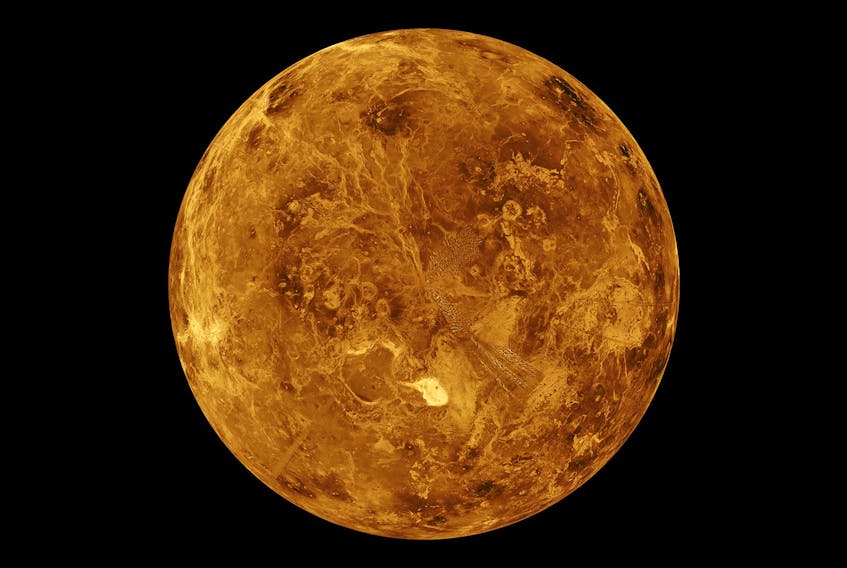Have you ever seen a very bright "star" sitting all by itself in the western sky just after sunset, or in the eastern sky just before sunrise, with no other stars visible in the sky?

What you are seeing is not a star, but the planet Venus, second planet from the sun. Named for the Roman goddess of love, sex, beauty, prosperity and fertility, Venus is the only planet named after a female. It was an important celestial object in many ancient civilizations, and was often associated with the gods.
Since Venus is often only visible either as a "morning star" in the east just before sunrise, or in the west as an "evening star" just after sunset, some ancient cultures thought of Venus as two separate objects. The ancient Greeks named Venus's two aspects Phosphorus (morning) and Hesperus (evening), both sons of the dawn goddess Eos. In their mythology, the ancient Romans recognized Venus as a single entity, but they also referred to the two aspects by two different names - Lucifer (morning) and Vesper (evening). To the ancient Chinese, the morning aspect of Venus was "the Great White" or "Opener of Brightness," while the evening aspect was "the Excellent West One."
It is thought that, as early as 4,000 BC, the ancient Sumerians were the first to recognize Venus as a single celestial object, naming it "Inanna" after the Mesopotamian goddess of love, beauty, sex, fertility, war, justice and political power. To the ancient Babylonians, it was Ninsi'anna - "the divine lady, illumination of heaven."
Though Mercury is closer to the sun, Venus is the hottest planet, with surface temperatures exceeding 465C. Venus has the distinction of being the second-brightest celestial object in the night sky after the moon, with an apparent magnitude of -4.8.; bright enough to cast shadows. This brightness is due to the dense, opaque layer of highly reflective clouds of sulphuric acid covering the planet, which reflects the sun's light.
Venus is one of the four "terrestrial" planets - Mercury, Venus, Earth and Mars - whose composition is primarily silicate rocks and metals. The dense atmosphere of Venus (the densest of the four inner solar system planets) is comprised of 95 per cent carbon dioxide and 3.5 per cent nitrogen.
The brightness is due to the dense, opaque layer of highly reflective clouds of sulphuric acid covering the planet, which reflects the sun's light.
Venus has often been called a "sister planet" or "twin planet" to Earth, due to the fact that the two planets are similar in size and mass. With a diameter of approximately 12,104 kilometres, Venus is only about 638 km smaller than Earth. However, its atmospheric pressure is 92 times that of Earth's. It orbits at .72 AU/108 million kms from the sun. Under the right circumstances, Venus can even be seen in broad daylight with the naked-eye, though you would need a very clear sky, and know exactly where to look in the daytime sky. It is said that the famous astronomer Edmund Halley saw Venus during the day, as did Napoleon Bonaparte and Abraham Lincoln.
As with Mercury, Venus has an "inferior" orbit (inside that of Earth) around the sun, with the result that it, too, can transit (pass in front of) the sun. However, because the orbit of Venus is inclined slightly from that of Earth, when Venus passes between the Earth and the sun, it does not always transit across the sun's disc, as viewed from Earth. This only happens when Venus's inferior conjunction coincides with the planet being lined up with Earth's orbital path around the sun, an event that occurs in a cycle every 243 years. The Venusian transits follow a pattern of paired transits separated by eight years at intervals of approximately 105-121 years; the last pairs were June 8, 2004 and June 5-6, 2012, with the next pair coming in Dec. 2117 and Dec. 2125. Captain James Cook, while exploring Australia in 1768, sailed to Tahiti to observe a transit of Venus. Venus is closest to Earth (an average of 41 million kms) when the planet is at inferior conjunction every 584 days;
Venus orbits the sun every 224.7 Earth days, and completes one rotation every 243 Earth days. While most planets rotate around their axes in a counter-clockwise (west to east) direction (as viewed from above Earth's north pole), Venus rotates around its axis in a clockwise (east to west) direction. It is theorized that this clockwise spin occurred at some point when the planet was being formed in the solar nebula that birthed all the planets of our solar system.
Like its diminutive neighbour, Mercury, Venus has no moons or rings, although it does have a number of small "trojan" asteroids that share its orbital path around the sun.
Another unique aspect of Venus is that its orbit around the sun is nearly circular, while those of the other planets in our solar system are elliptical.
Because the planet's opaque cloud cover prevents any ground-based telescopic observation, modern-day exploration of Venus didn't really commence until America's first successful interplanetary mission, Mariner 2, visited the planet in 1962. This was followed five years later with the Soviet's successful landing of its Venera 4 spacecraft on the Venusian surface on Oct. 18, 1967 (the first spacecraft to land on another planet). Other missions to Venus followed - America's Mariner 10 flyby (1974); the Soviet's Venera 9 and 10 missions (1975 - first black and white photos of the Venusian surface); NASA's Pioneer Venus Project orbiter and multiprobe (1978); the Soviet's Venera 13 and 14 missions (1982 - first colour photos of surface); and the Soviet's Venera 15 and 25 orbital missions (1983).
Numerous flybys of Venus by NASA have also contributed to knowledge of this hidden planet - Vega 1 and 2 (1985); Galileo (1990); Magellan (1994); Cassini-Huygens (1998);and MESSENGER ((2006). The European Space agency (ESA) sent a spacecraft, Venus Express, in 2006, while Japan put a spacecraft, Akatsuki, into orbit around the planet in 2015.
Venus, like Mercury, is currently too close to the Sun to be seen, but will be visible later this month.
Until next time, clear skies.
Glenn K. Roberts lives in Stratford, P.E.I., and has been an avid amateur astronomer since he was a small child. He welcomes comments from readers, and anyone who would like to do so is encouraged to email him at [email protected].
Events:
Oct. 19 - Mercury at greatest eastern elongation








